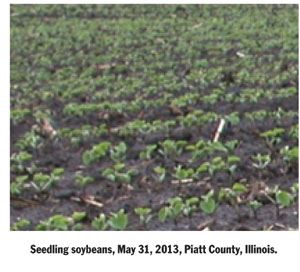Delayed Soybean Planting: Prospects For Insect Injury
URBANA, ILL.
The stormy spring weather across much of the nation’s mid-section continues to cause planting delays. Planting estimates (USDA NASS, May 28, 2013) indicate that approximately 40 percent of Illinois soybean acres have been planted. Roughly 12 percent of the soybean crop has emerged across the state. These percentages are well below the five-year averages for Illinois by this date – 53 percent planted and 28 percent emerged. As overwintering bean leaf beetles break dormancy and begin to seek out soybean fields, those fields that are first to emerge will be most susceptible to early season feeding. Overwintering adults typically become active in April and initially may spend most of their time feeding within alfalfa or clover. As soybean plants become available in May and June, they become a preferred host. Fields most at risk this spring would include those that were planted first within an area and are now serving as a very attractive trap crop. These fields should be scouted for signs of defoliation. Fortunately, a rescue treatment for seedling soybeans is most often not justified because densities of 16 beetles per foot of row (early seedling stage) or 39 adults per foot of row at the V2+ stage of development are necessary for economic injury.

Continuing delays in soybean planting could dim the prospects for soybean aphid establishment this season. Infestations of this insect pest have become less predictable and more sporadic the last several years in many areas of the Midwest. Soybean aphids first detected in North America (Wisconsin) in July of 2000, quickly spread to 10 North Central states by September of that same year. At the conclusion of the 2003 summer, they could be found in 21 states and three Canadian provinces. Entomologists have learned a great deal about this aphid species during the past 13 years and have developed some very sound economic thresholds that can be used in the effective management of this insect pest. Currently, alate (winged) viviparous (give birth to living young, nymphs) females are flying from their primary and overwintering host (common buckthorn) to their secondary host (soybean plants). These spring migrants may have more challenges this year locating soybean fields that are ready to receive them. It’s too early to offer any kind of firm predictions for soybean aphids this year. More moderate summer temperatures would work in favor of soybean aphids. For now, it appears they may have some establishment hurdles to clear this spring.
Management questions regarding soybean aphids and bean leaf beetles are often intertwined. A paper published in 2008 by some entomologists at Iowa State University provided some helpful insights regarding the use of insecticidal seed treatments and early-season rescue treatments in soybeans. They determined that neither of these approaches that targeted early-season bean leaf beetle densities had much value for overall soybean aphid management. For more information about this 3-year investigation, I encourage you to take a look at this useful journal article.
Johnson, K.D., M.E. O’Neal, J.D. Bradshaw, and M.E. Rice. 2008. Is preventative, concurrent management of the soybean aphid (Hemiptera: Aphididae) and bean leaf beetle (Coleoptera: Chrysomelidae) possible? Journal of Economic Entomology 101(3): 801-809. Δ
DR. MICHAEL GRAY: Professor Crop Sciences Extension Coordinator & Assistant Dean for ANR Extension Programs, University of Illinois